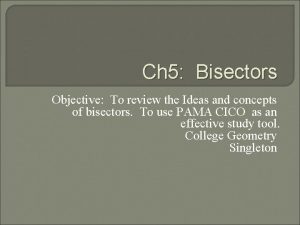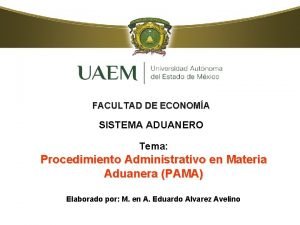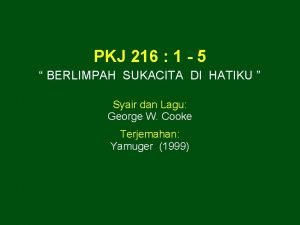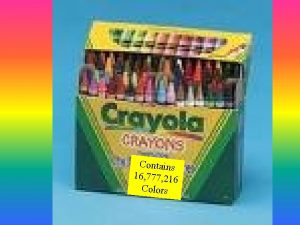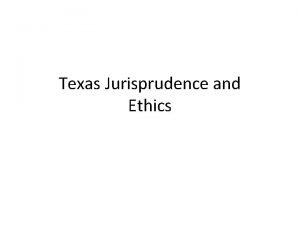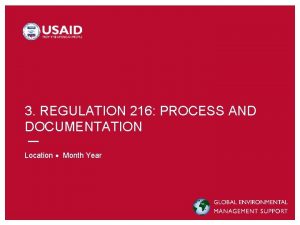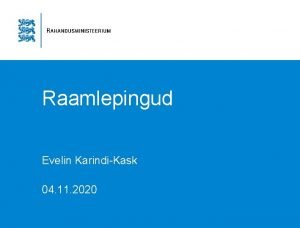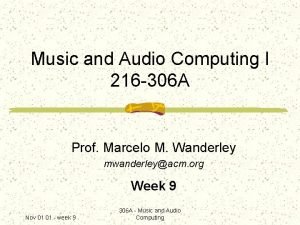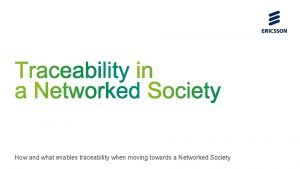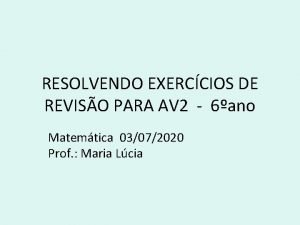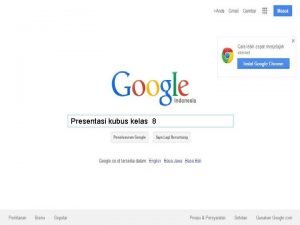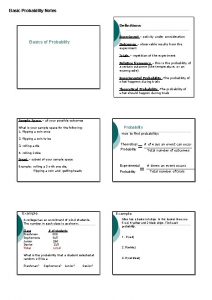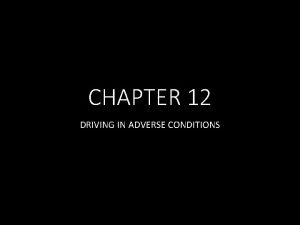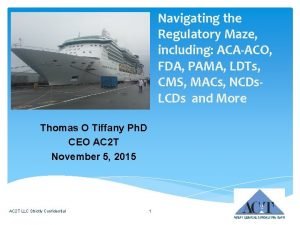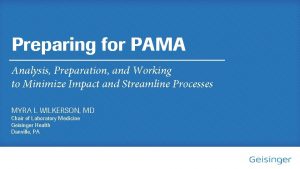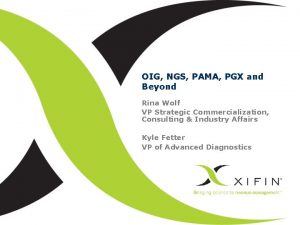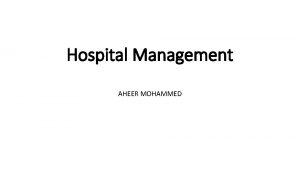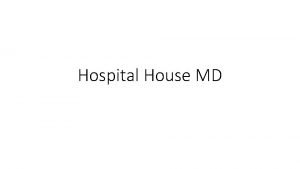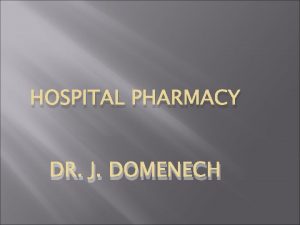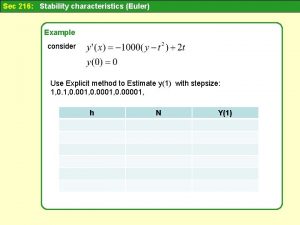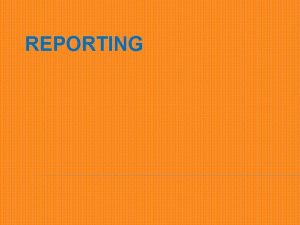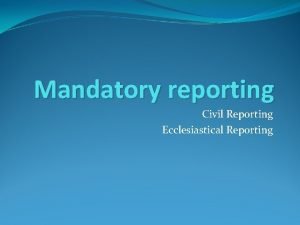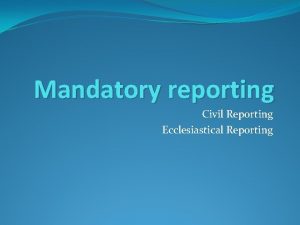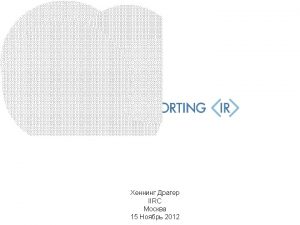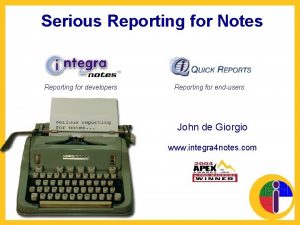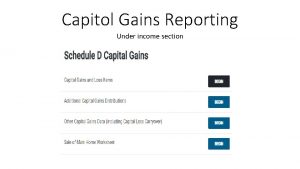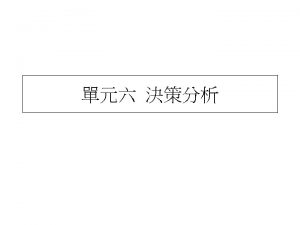Hospital Reporting Under PAMA Sec 216 What you





























- Slides: 29

Hospital Reporting Under PAMA Sec. 216 What you Need to Know to Comply with CMS’s New Data Collection and Reporting Requirements for Hospitals American Clinical Laboratory Association 1100 New York Avenue, NW Suite 725 West Washington, DC 20005 (202) 637 -9466 www. acla. com

Overview 1. Statutory Background of PAMA Sec. 216 2. How to Know Whether You Are Required to Report 3. How to Report 2

Questions addressed WHO needs to report private payor rates to CMS? WHAT needs to be reported? WHEN does reporting happen? HOW is reporting done? WHAT are possible penalties for failure to report? WHERE can hospitals find answers to questions about PAMA reporting? 3

Sec. 216 of PAMA • Sec. 216 of the Protecting Access to Medicare Act (PAMA) became law in April 2014 • Changed the way that rates are set on the Clinical Laboratory Fee Schedule (CLFS) for the first time in 30 years • Intended to create a market-based system under which CLFS rates are derived from information reported by labs about their private payor rates and volumes • All entities that are reimbursed under the CLFS for laboratory services are subject to the rates – hospitals, physician office laboratories, independent laboratories – regardless if they report data to CMS 4

Sec. 216 of PAMA – the basics • Requires “applicable labs” to report “applicable information” to CMS (private payor rates and volumes) • Establishes data collection periods and data reporting periods • Authority for CMS to impose Civil Monetary Penalties for non-reporting, omissions, misrepresentations • Creates a new category of test – “advanced diagnostic laboratory test” – with its own data reporting and payment rules • Sets forth coding requirements for certain new and existing tests • Creates Advisory Panel on Clinical Diagnostic Laboratory Tests to assist CMS with technical aspects of implementation 5

PAMA rulemaking • CMS issued a proposed rule about three months after the deadline for issuing a final rule • Statute calls for first data reporting period in 2016 and new CLFS rates in 2017; final rule pushed everything back one year • The first data collection period was Jan. 1 – June 30, 2016 • The first data reporting period was scheduled to be Jan. 1 – Mar. 31, 2017 – extended two months because of technical difficulties • Preliminary rates released Sept. 2017; final rates released Nov. 2017 • New CLFS rates went into effect Jan. 1, 2018 • Some regulations were amended in the CY 2019 Physician Fee Schedule Final Rule, applicable to future data collection and reporting cycles 6

The LAB Act of 2019 • Passed in December 2019, the Laboratory Access for Beneficiaries (LAB) Act delayed the data reporting period until 2021 so that applicable laboratories will not have to report applicable information to CMS in 2020. • The LAB Act also called for a study on how to implement a less burdensome data reporting process that would still result in market-based rates on the CLFS and would be representative of the entire laboratory market, as Congress originally intended. 7

What the LAB Act means for you What’s changed? The data reporting period has now been delayed by one year. Applicable labs are now scheduled to report data in Q 1 of 2021. Increased reporting is still critical! Applicable labs are encouraged to use the one-year delay to review the accuracy of data collected and prepare for submission. What hasn’t changed? The data collection period remains the same. Applicable labs must report data from the second collection period (Jan 1 -June 30, 2019). Scheduled reimbursement cuts remain in place. Reduction cap is 10% in 2020, 15% in 2021, 2022, and 2023. CMS will continue to rely on previously collected data for basis for implementing new reimbursement cuts in 2021. 8

Timeline 2016 2017 JUN. 16: Final rule released JAN. 1 – JUN. 30: 2018 2019 JAN. 1 – JUN. 30: New rates effective JAN. 1: JAN. 1 – MAY 31: First data collection periodreporting period SEPT. 22: CMS releases preliminary payment rates, followed by 30 day comment period NOV. 17: CMS releases final payment rates Second data collection period 2020 2021 JAN. 1 – MAR. 31: Second data reporting period 2022 Repeat 2022 JAN. 1: New rates effective JUNE: Med. Pac study sent to Congress and CMS Cycle of data collection, reporting, and rate-setting is scheduled to continue every three years SEPT. : CMS releases preliminary payment rates, followed by 30 day comment period NOV. : CMS releases final payment rates 9

Who reports data to CMS? In other words, what is an applicable laboratory? • An entity that: • Is a laboratory, as defined in § 493. 2 of this chapter; • Bills Medicare Part B under its own National Provider Identifier (NPI); • • • For hospital outreach laboratories—bills Medicare Part B on the CMS-1450 under bill type 14 x; In a data collection period, receives more than 50 percent of its Medicare revenues, which includes fee-for-service payments under Medicare Parts A and B, prescription drug payments under Medicare Part D, and any associated Medicare beneficiary deductible or coinsurance for services furnished during the data collection period from one or a combination of the following sources: • This subpart G (Clinical Laboratory Fee Schedule) • Subpart B of this part (Physician Fee Schedule) [During a data collection period] receives at least $12, 500 of its Medicare revenues from [the CLFS]. Except, for a single laboratory that offers and furnishes an ADLT, this $12, 500 threshold — • Does not apply with respect to the ADLTs it offers and furnishes; and • Applies with respect to all the other CDLTs it furnishes. 10

Who reports data to CMS? IF A hospital laboratory has its own NPI or the hospital bills Medicare using a 14 x type of bill for services furnished to non-hospital patient AND The majority of the laboratory’s Medicare revenues are from the CLFS and/or PFS AND The hospital laboratory receives more than $12, 500 in CLFS revenue in the first six months of 2019 THEN The hospital laboratory qualifies as an applicable laboratory and must report applicable information to CMS in the first three months of 2020 11

Who reports data to CMS? Majority of Medicare revenues equation: CLFS + PFS revenue Medicare Part A, B, and D revenue Hospital outreach laboratory = “A hospital laboratory that furnishes laboratory tests to patients other than inpatients or registered outpatients of a hospital. ” Examples of applying the equation: • Hospital outreach laboratory bills under its own NPI for its non-patient services: • Uses only its own revenue to determine whether CLFS + PFS revenue > 50% of NPI’s Medicare revenue, and it received > $12, 500 in CLFS revenue in data collection period 12

Who reports data to CMS? Examples continued: • Hospital outreach laboratory and two other outreach laboratories bill under another hospital outreach laboratory’s NPI for non-patient services: • Uses combined revenue from all outreach labs to determine whether CLFS + PFS revenue > 50% of NPI’s Medicare revenue, and together they received > $12, 500 in CLFS revenue in data collection period • Hospital has three outreach labs; one bills Medicare for non-patient services under its own NPI, and the other two bill Medicare for non-patient services under the hospital’s NPI: • Laboratory with its own NPI uses only its own revenue to determine whether CLFS + PFS revenue > 50% of NPI’s Medicare revenue, and it received > $12, 500 in CLFS revenue in data collection period • Laboratories billing under the hospital’s NPI use only 14 x TOB revenue to determine whether CLFS + PFS revenue > 50% of NPI’s Medicare revenue, and it received > $12, 500 in CLFS revenue in data collection period 13

Applicable Information: What’s In and What’s Out? 14

What data is reported? In other words, what is applicable information? What is a private payor? • HCPCS code for each test • A health insurance issuer • Private payor rate for each test for which final payment has been made during the data collection period • A group health plan • Volume for each test at each private payor rate • Medicaid Managed Care organization • Medicare Advantage plan 15

What data is reported? • Final payments made during a data collection period (DCP) • • Payments from secondary insurers made during a DCP • • Rate reported should be 100% percent of payor’s fee schedule (which includes patient costsharing, if applicable) Report whether cost-sharing amounts collected during DCP or not Multiple payment rates for same test from same payor • • Reported rate = 100% of the primary payor’s fee schedule amount (final payment from primary payor + any patient cost-sharing amounts + payment from secondary insurer) DO NOT report payments from secondary insurers separately Patient cost-sharing amounts • • Initial claim paid in error before DCP and final correct amount paid during DCP = IN Initial claim paid in error during DCP and final correct amount paid after DCP = OUT Appeals resolved during the DCP = IN Report each unique payment rate with the associated volume at that rate Manual remittances • Sorry, folks, these are included, too… 16

What data is NOT reported? • Rates for tests paid only under the PFS • Price concessions applied by a laboratory • Denied payments and zeroes • Unresolved appeals • Payments made on a capitated basis • Payments where the associated test volume isn’t clear from the remittance • Remittances where a payor has grouped individual HCPCS code payments into an encounter- or claim-level payment • Estimated payments General rule: If you cannot correlate a payment amount and volume to a specific HCPCS code, it is not applicable information and it’s not reported. 17

Hospital outreach laboratories, take note: Q Do hospital outreach laboratories that are applicable laboratories based on the revenues attributed to the 14 x TOB only need to collect and report the private payor data that is billed using a 14 x TOB, or would hospital outreach laboratories need to collect and report private payor data that is billed in other ways, as well? A Reporting applicable information is not discretionary. If the hospital outreach laboratory is an applicable laboratory it would be responsible for collecting and reporting all applicable information attributed to its applicable laboratory. When a hospital outreach laboratory is an applicable laboratory as defined by revenues attributed to the 14 x TOB, applicable information for all non-patient laboratory test services must be reported, regardless of the TOB required by the private payor for laboratory tests furnished to non-patients. 18

Hospital outreach laboratories, take note: Q What if the private payor does not use the form CMS-1450 14 x TOB for laboratory tests furnished to non-hospital patients? A In circumstances in which a private payor does not require a hospital outreach laboratory to use the form CMS-1450 14 x TOB, the hospital must distinguish between private payor fee-for-service payments (and the associated volume) for laboratory tests furnished to non-patients (the applicable laboratory) from private payor fee-for-service payments (an associated volume) for laboratory tests furnished to hospital patients. For example, if a private payor requires a hospital laboratory to use the CMS-1450 13 x TOB for laboratory tests furnished to hospital outpatients and non-hospital patients (instead of the 13 x TOB for hospital outpatients and the 14 x TOB for non-hospital patients), the hospital must develop a mechanism to identify the private payor rates and corresponding volume furnished to non-hospital patients. 19

When does reporting happen? Data Collection Period Review and Validation Period Data Reporting Period Used for CLFS Rate Years Jan. 1 – Jun. 30, 2019 Jul. 1 – Dec. 31, 2019 Jan. 1 – Mar. 31, 2021 2022 – 2024 Continues every third subsequent calendar year New CLFS rate every three years • Rates that are reported are final payments received during the Data Collection Period • Use the six months between the Data Collection Period and the Data Reporting Period to collect, review, organize, and validate the data that will be reported • Data Reporting can happen any time during the Data Reporting Period 20

How is reporting done? • The reporting entity is the TIN-level entity that reports for all component applicable laboratories. • The reporting entity and the applicable laboratory may be the same entity. Examples: • A TIN-level entity reports on behalf of its five laboratories, each with their own NPIs and each that qualify as applicable laboratories. The TIN-level entity reports separately on behalf of five applicable laboratories. • A TIN-level entity consists of five laboratories, each with their own NPIs but only three of which qualify as applicable laboratories; it reports on behalf of the three that are applicable laboratories. • A TIN-level entity consists of five laboratories that all bill under one NPI and that collectively qualify as an applicable laboratory; the TIN-level entity reports applicable information for one applicable laboratory, consisting of all laboratories associated with the NPI. • A TIN-level entity includes one hospital outreach laboratory that qualifies as an applicable laboratory; the TIN-level entity reports applicable information attributable to the hospital outreach laboratory only. • A TIN-level entity includes two laboratories that use the hospital’s NPI (collectively they qualify as an applicable laboratory) and one laboratory that uses its own NPI to bill for non-hospital patients and qualifies as an applicable laboratory. The TIN-level entity reports on behalf of two applicable laboratories: (1) the labs that bill under the hospital’s NPI, and (2) the lab that bills under its own NPI. 21

More on reporting… • The reporting entity must ensure accurate collection and reporting of applicable information on behalf of its applicable laboratories. • • Voluntary reporting is not permitted. • • • The President, CEO, or CFO of a reporting entity, or an individual who has been delegated authority to sign for, and who reports directly to, such an officer, has to certify the accuracy and completeness of the data reported. Not an applicable laboratory? Don’t report. Reporting applicable information is not discretionary. • An applicable laboratory? Report. • And report all data that qualifies as applicable information. The Secretary may impose a Civil Monetary Penalty of up to $10, 000 per day for each misrepresentation or omission in reporting applicable information. 22

Registration for Clinical Laboratory Data System • • • For each TIN-level “applicable lab” that will be reporting data in this data reporting period, a CLFS Submitter and a CLFS Certifier must register for an account in the CMS Enterprise Portal: https: //portal. cms. gov • Submitter and Certifier cannot be the same person for a TIN-level entity • Same person can act as a Submitter for more than one TIN-level entity, and same person can act as a Certifier for more than one TIN-level entity After registration, must request access to the CLFS Data Collection System (one of many reporting systems in the CMS Enterprise Portal) • Involves a “soft credit check” to verify identity • Approval may take up to 72 hours Registration is a multi-step process and a registration has to be approved before data can be submitted – do not wait until the last minute to register! 23

Registration for Clinical Laboratory Data System CLFS User Manual available on the PAMA website: https: //www. cms. gov/Medicare-Fee-for-Service. Payment/Clinical. Lab. Fee. Sched/Downloads/CLFS-Data-Collection-System-User-Guide. pdf. 24

Data submission and certification • Link to reporting template for uploading data is online at: • https: //www. cms. gov/Medicare-Fee-for-Service-Payment/Clinical. Lab. Fee. Sched/PAMARegulations. html • Can change the file name of the reporting template, but not the column names, column numbers, values • Duplicate data is allowed • Payors do not have to be separated out by line • Validation errors: • No data are saved until all data are correct • If there are errors (e. g. , HCPCS code with 6 digits, or a private payor rate with a letter in it), you will get an error message at the line level • When all errors are corrected, data can be uploaded and saved 25

Where can you find more info? • 42 U. S. C. § 1395 m-1 (added by PAMA Sec. 216) • PAMA Final Rule: 81 Fed. Reg. 41036 (Jun. 23, 2016) • CY 2019 Physician Fee Schedule Final Rule: 83 Fed. Reg. 59452 (Nov. 23, 2018) • 42 C. F. R. §§ 414. 500 – 414. 504 (Payment for Clinical Diagnostic Laboratory Tests) • CMS Website, PAMA Regulations, Guidance, FAQs: • • https: //www. cms. gov/Medicare-Fee-for-Service-Payment/Clinical. Lab. Fee. Sched/PAMARegulations. html ACLA Website, PAMA: • https: //www. acla. com/pama/ 26

Increased reporting is critical! Less than 1% of all labs reported data in 2017 Hospitals contributed 1% of data in first reporting period, even though hospital labs make up approximately 26% of CLFS spending Physician office labs made up 7. 5% of data submitted, despite representing approximately 20% of CLFS spending All labs are subject to PAMA rates Commonly ordered tests subject to cuts of greater than 30% 27

PAMA slashes top 10 lab tests HCPCS Description Annual Test Volume 2017 Effective Rate Weighted Median Percent Change 84443 Assay thyroid stim hormone 21, 168, 378 $23. 00 $14. 87 -35% 80053 Comprehensive metabolic panel 40, 644, 516 $14. 01 $9. 08 -35% 85025 Complete cbc w/auto diff wbc 41, 047, 544 $10. 56 $6. 88 -35% 80061 Lipid panel 27, 250, 027 $17. 86 $11. 23 -37% 82306 Vitamin d 25 hydroxy 8, 836, 881 $40. 35 $26. 37 -35% 83036 Glycosylated hemoglobin test 18, 999, 605 $13. 29 $8. 50 -36% G 0483 Drug test def 22+ classes 1, 175, 501 $246. 53 $193. 71 -21% 80048 Metabolic panel total ca 13, 320, 608 $11. 19 $8. 06 -28% G 0482 Drug test def 15 -21 classes 774, 326 $202. 15 $132. 00 -35% 83970 Assay of parathormone 2, 123, 536 $56. 62 $36. 76 -35% 28

For questions, or to stay in the loop about upcoming educational opportunities, please contact info@acla. com or call 202 -637 -9466. 29
 Pama reporting 2019
Pama reporting 2019 Cico pama
Cico pama Pama technological support
Pama technological support Acta de inicio de pama
Acta de inicio de pama You take $100 you had kept
You take $100 you had kept 100 bedded hospital staff requirements
100 bedded hospital staff requirements Pkj 216 not angka
Pkj 216 not angka 216 lcm
216 lcm Um veículo desloca-se com velocidade de 216 km
Um veículo desloca-se com velocidade de 216 km Onlyblue00
Onlyblue00 Mission of bon supersedes
Mission of bon supersedes Ley 18 216
Ley 18 216 72 sayısının kaç tane pozitif tamsayı böleni vardır
72 sayısının kaç tane pozitif tamsayı böleni vardır Me 216
Me 216 Reg 216
Reg 216 Gina sells 216 cakes
Gina sells 216 cakes Evelin karindi-kask
Evelin karindi-kask Roman military unit
Roman military unit ` (i) `216
` (i) `216 I^216
I^216 Ericsson bkv-301-216/130
Ericsson bkv-301-216/130 Economic 216
Economic 216 Raiz cubica 216
Raiz cubica 216 Presentasi matematika tentang kubus
Presentasi matematika tentang kubus Pony motor starting synchronous motor
Pony motor starting synchronous motor 216*500
216*500 An activity under consideration is called
An activity under consideration is called Controlled braking definition
Controlled braking definition You say you love the rain but you open your umbrella
You say you love the rain but you open your umbrella Agree or disagree questions about life
Agree or disagree questions about life

